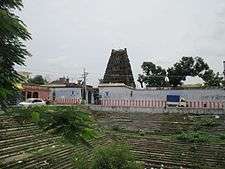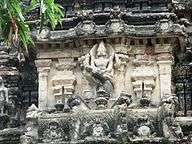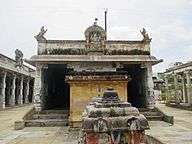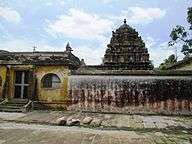Pavalavannam Temple
| Tiru Pavala Vanam | |
|---|---|
 | |
 Tiru Pavala Vanam Location in Tamil Nadu | |
| Geography | |
| Coordinates | 12°50′40″N 79°42′16″E / 12.84444°N 79.70444°ECoordinates: 12°50′40″N 79°42′16″E / 12.84444°N 79.70444°E |
| Country | India |
| State | Tamil Nadu |
| District | Kanchipuram |
| Location | Kanchipuram |
| Architecture | |
| Architectural styles | Dravidian architecture |
Tiru Pavala Vannam or Pavalavanam temple located in Kanchipuram in the South Indian state of Tamil Nadu, is dedicated to the Hindu god Vishnu. Constructed in the Dravidian style of architecture, the temple is glorified in the Divya Prabandha, the early medieval Tamil canon of the Azhwar saints from the 6th–9th centuries AD. It is one of the 108 Divyadesam dedicated to Vishnu, who is worshipped as Pavalavannar Perumal and his consort Lakshmi as Pavazhavalli.
The temple is believed to have been built by the Cholas, with later contributions from Medieval Cholas and Vijayanagar kings. The temple has three inscriptions on its walls, two dating from the period of Kulothunga Chola I (1070–1120 CE) and one to that of Rajadhiraja Chola (1018-54 CE). A granite wall surrounds the temple, enclosing all the shrines and two bodies of water. There is a seven-tiered rajagopuram, the temple's gateway tower, in the temple.
Pavalavannar is believed to have appeared to sage Naimisaranya. Six daily rituals and three yearly festivals are held at the temple, of which the Brahmotsavam festival, celebrated during the Tamil month of Vaikasi (May - June), being the most prominent. The temple is maintained and administered by the Hindu Religious and Endowment Board of the Government of Tamil Nadu.
Legend
It is believed that Vishnu assumed various colours during various eras according to the nature of the living beings and their behaviour. During Krita Yuga, people were well-behaved (satvaguna) and Vishnu was white (called svetavarna) in colour. During Tretayuga, he assumed the colour of Pavalam (emerald) and hence came to be known as Pavalavannar or Pralavannar (in Sanskrit). In Dvapara Yuga, he assumed green colour (pachai in Tamil). In the current Kali Yuga, he assumed blue tint called syamalavarna and it is believed that people will not be influenced by the form Vishnu appears. Vishnu is believed to have appeared for twin Aswini gods as Pavalavannar and hence retains the name in modern times.[1][2]
History
The temple has various inscriptions from the Chola (10th -12th centuries) and Vijayanagar period (15-16th centuries). The temple is originally believed to be built during the period of Medieval Cholas. In modern times, the temple was maintained and administered by hereditary trustees, but a litigation during the 2014 from the Chennai High Court split the control between the trustee and the Hindu Religious and Endowment Board of the Government of Tamil Nadu.[3] Among the 12 alwars (the great saints in Vaishnavite tradition) three of them namely Peyalvar, Thirumalisai Alvar and Thirumangai Alvar have sung on the different forms of God in this temple. Many acharyas have also written songs on the various forms of God in this Temple. The temple faces west and the twin aswins have worshipped the Lord here.[4][1]
Architecture
The central shrine of the temple has the image of presiding deity, Pavalavannar in standing posture. The festive image of the presiding deity and that of Santhanagopala Krishnan are located inside the sanctum. The West facing sanctum is approached through the flagstaff, pillared halls, namely Mahamandapam and the Ardhamandapam. The roof of the sanctum is called Vedasara Vimana and it has five kalasams and stucco images of various legend. The temple has separate shrines for Azhwars located to the North of the flagstaff. The pillars in the hall are sculpted with images of Nammazhwar, Ramanujar, Manavala Mamunigal and various avatars and legends of Vishnu. There are other shrines of Rama along with Seetha and Hanuman and Garuda. The vimana of the central shrine is called Vedasara Vimana. The shrine of Pavazhavalli, the consort of Pavalavannar, is located facing the central shrine in the Eastern side of the temple. The temple has two precincts with the second precinct enclosed by granite walls pierced by a five tiered rajagopuram (gateway tower). The gopuram is studded with stucco images of various legends, with the notable among them being the representation of Narasimha, an avatar of Vishnu slaying the demon Hiranya. A shrine of Manavala Mamunigal is located to the left of the gopuram from the entrance. The temple tank, Chakra Theertham, is located to the North east direction from the entrance.[1]
Festivals and religious practices

The temple follows the traditions of the Thenkalai sect of Vaishnavite tradition and follows vaikanasa aagama. The temple priests perform the pooja (rituals) during festivals and on a daily basis. As at other Vishnu temples of Tamil Nadu, the priests belong to the Vaishnavaite community, a Brahmin sub-caste. The temple rituals are performed six times a day: Ushathkalam at 7 a.m., Kalasanthi at 8:00 a.m., Uchikalam at 12:00 p.m., Sayarakshai at 6:00 p.m., Irandamkalam at 7:00 p.m. and Ardha Jamam at 10:00 p.m. Each ritual has three steps: alangaram (decoration), neivethanam (food offering) and deepa aradanai (waving of lamps) for both Pavalavannar Perumal and Pavazhavalli. During the last step of worship, nadaswaram (pipe instrument) and tavil (percussion instrument) are played, religious instructions in the Vedas (sacred text) are recited by priests, and worshippers prostrate themselves in front of the temple mast. There are weekly, monthly and fortnightly rituals performed in the temple.[5] Brahmotsavam celebrated during the Tamil month of Vaikasi (May - June) is the major festival of the temple.[1][6] Pavitrotsavam celebrated during the Tamil month of Panguni (March - April) and Vaikunta Ekadasi during Margazhi (December - January) are the other festivals celebrated in the temple.[5]
References
- 1 2 3 4 T.V.R, Chari (1982). The Glorious temples of Kanchi. Big Kancheepuram: Sri Kanchi Kamakshi Ambal Devasthanam and Sarada Navaratri Kalai Nigazhchi Trust. pp. 78–82.
- ↑ Ayyar, P. V. Jagadisa (1991). South Indian shrines: illustrated. New Delhi: Asian Educational Services. p. 539. ISBN 81-206-0151-3.
- ↑ "Before the Commissioner, H.R. & C.E Admin Department, Chennai-34" (PDF). Hindu Religious and Endowment Board, Government of Tamil Nadu. 2014. pp. 1–3.
- ↑ Ayyar, P. V. Jagadisa (1991). South Indian shrines: illustrated. New Delhi: Asian Educational Services. p. 539. ISBN 81-206-0151-3.
- 1 2 "Sri Pavalavannaperumal temple". Dinamalar. 2014. Retrieved 31 May 2014.
- ↑ Knapp, Stephen (2009). Spiritual India Handbook. Jaico Publishing House. ISBN 9788184950243.
External links
| Wikimedia Commons has media related to Pavalavannam Temple. |



